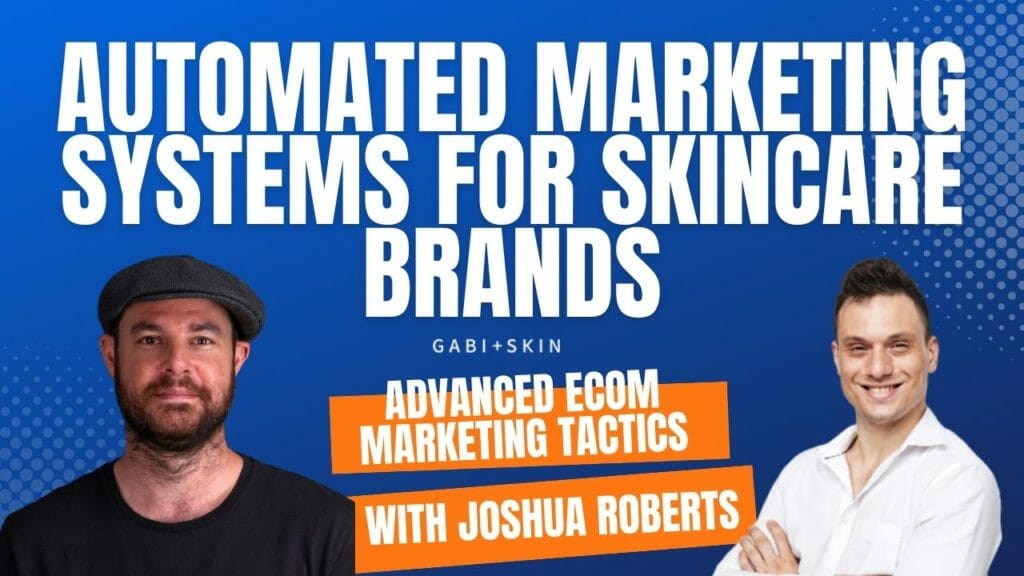Podcast: Play in new window | Download (Duration: 22:31 — 20.6MB)
Subscribe: Apple Podcasts | Spotify | RSS
Introduction: Joshua Roberts
Hi everyone, I’m very excited to have Joshua Roberts in the show. Joshua used to be in the corporate world as the creative marketing director of Acer.
Then, he was able to transfer his knowledge and skill set that he gained working for multinational corporations. He started his own business 4–5 years ago, as well as his own eCommerce brand on Shopify, GABI+SKIN, a skincare product.
He wants to talk a little bit about what skill set made him successful, especially in creating templates and automation and streamlining processes within this eCommerce store.
I also want to share a few words about this podcast. We are here on a mission to help eCommerce entrepreneurs to listen to successful 7–8 figure shop owners, who are sharing tactics and tips on growing the eCommerce store.
If you’d like to connect to the speakers of this podcast, then I would encourage you to also join our Facebook group where guests like Joshua will be part of. Without further ado, let’s get into the show.
I’m excited to host Joshua Roberts on the show today. Joshua and I have been friends for a couple of years, and I met him through a mutual friend. Josh is also in the eCommerce space and also in the startup space. He is running an eCommerce brand which is doing skincare, which he will introduce in a bit.
It’s called GABI+SKIN. And, in his web development agency called The Level, he is focusing on branding and web development. Josh, welcome to the show.
Episode Highlights
We’ve made the branding and the design look like it—it’s like an imported product, it has a more international feel to it, a more minimalist feel than some of the things that you would see pop up here. (10:11)
What we now do for our products with GABI+SKIN, we basically templatize the workflow. We automated a lot of the design materials using database-driven design. I’m all about saving time because we’re still a small team. There’s only a few people supporting this brand, full-time. I’m not even full-time on it right now, because I still manage Level. (14:32)
All of our primary SEO activities are done through blogging and recycling our blogging content. It’s all pretty much automated through an editorial calendar that automatically notifies the ghostwriters that we have. (16:30)
We use a mixture of paid media; organic search through SEO, email marketing, we use Klaviyo—an amazing tool—and influencer marketing. (20:36)
The form on our website has nearly a 50% registration rate in Klaviyo, for the people who enter this page. Around 50% fill out this form. A three X return on Ad Spend—it’s the most successful thing that we have going on so far. (24:22)
The other thing that we did is, we put a message on all of our product pages that say, “When you order products from us, we will include the samples. You can try the samples first. If you don’t like the product, send it back. Within 30 days, you get your full money back and you’ve lost nothing. We’ll pay for everything.” To date, in two years, we have one single return. (25:38)
We get user-generated content through a Shopify App. That’s one way. We use stamped.io. They have a really great review module. We do get lots of reviews and photos this way. We use Instagram to ask our customers for user-generated content in return for—sometimes, a straight up gift, or sometimes a chance to win a gift. (28:46)
GABI+SKIN Intro
GABI+SKIN was something we fell into in an organic way. We were running a branding design consultancy based in Taipei. We do brand identity design and web design. We were already in the agency space, building eCommerce sites for other companies, doing branding for other companies, sort of from elephants to ants, startups to bigger corporations.
We got into doing skincare because my wife was looking for a coffee scrub product in Taiwan, and we couldn’t find it. So, we looked overseas and we found an interesting brand in Australia. Then, we looked into the shipping and it cost more than the product. We thought, “Well, what goes into coffee scrub?”
It’s actually not a lot of complicated ingredients, everything that you’d normally have in your kitchen. We went down the street, picked up everything at Costco, and did it at home. My wife started using it and she loved it. We started giving it away and people started to ask us for more.
After a while, we said, “Well, we’re doing branding already. Maybe we could make a little website.” That’s how it started.
It started as a home project. It started as a need for yourself, and it developed into a startup to leverage your previous skill set. I forgot to mention that you actually also had a background in the corporate world. You have been doing user design for Microsoft and you have been working for Azure as the global creative marketing director. So, you brought a lot of skill sets to the table even before you started your own eCommerce store, right?
Yeah, exactly. Most of my career, I was on the corporate brand side in either a design or marketing role. I left Acer as the global creative director a little over four years ago to start Level. GABI+SKIN, we started a couple years after that.
GABI+SKIN Product Line
We chose the name GABI+SKIN because “GABI” in Taiwanese means “coffee.” It’s coffee plus skin. All of the products include coffee extract for some of the skin benefits that it brings, caffeine amongst others. And we have a total of six SKUs so far.
We’ve recently realized that we need to expand the product portfolio. That’s what our customers are asking for now. Our main goal this year is to grow the portfolio by another 3–5 products.
We’re in the midst of testing a few products now, and we’re getting better at it. Skincare was our background, though.
Primary Market: Taiwan
We are primarily focused in Taiwan because we didn’t want to expand too quickly and wear ourselves very thin. We are just a bootstrapped brand. We wanted to grow organically, focus on high-quality products and see what made sense, see how to reformulate the products if we needed to, before we expanded into different markets with different platforms. It would be difficult to make changes.
We really tried to focus on Taiwan, to begin with. We do have distribution in Hong Kong now, and we still sell 80% in Taiwan, and then Hong Kong, Singapore, U.S. We’re getting more and more sales, but all of our marketing is focused on Taiwan.
Target Audience and USP
The main differentiator between us and competing brands is that we’ve taken a pretty niche approach with the coffee extract, connecting directly to our name, GABI. All of the products include coffee extract. They also all include real essential oils. We’ve taken a pretty extreme approach to being eco-friendly, from the factory production process to the way we package the products.
It’s definitely not cheaper to do it this way, but it’s something we feel is really important. For Taiwan, the market loves imported products.
We've made the branding and the design look like it—it's like an imported product, it has a more international feel to it, a more minimalist feel than some of the things that you would see pop up here.
Joshua Roberts Tweet
From that perspective, I think we stand out a bit more. And then, from the pure product perspective, what we put inside the ingredients, we take the philosophy that what you put on your skin is just as important as what you put inside your body.
We leave out quite a lot of ingredients. There’s no alcohol, no parabens, etc., that are used in quite a lot of skincare products. They’re very inexpensive ways to kill bacteria and increase the shelf life.
A lot of our products don’t actually last as long, so we need to produce smaller batches, two to three-year shelf life. Most of them are around three years, because we use nicer ingredients. Vitamin E is a great ingredient to add to increase shelf life. There are some other things, as well. But, we’re refraining from using things like alcohol, because they really dry out your skin, even though the products will last for years when you add that stuff.
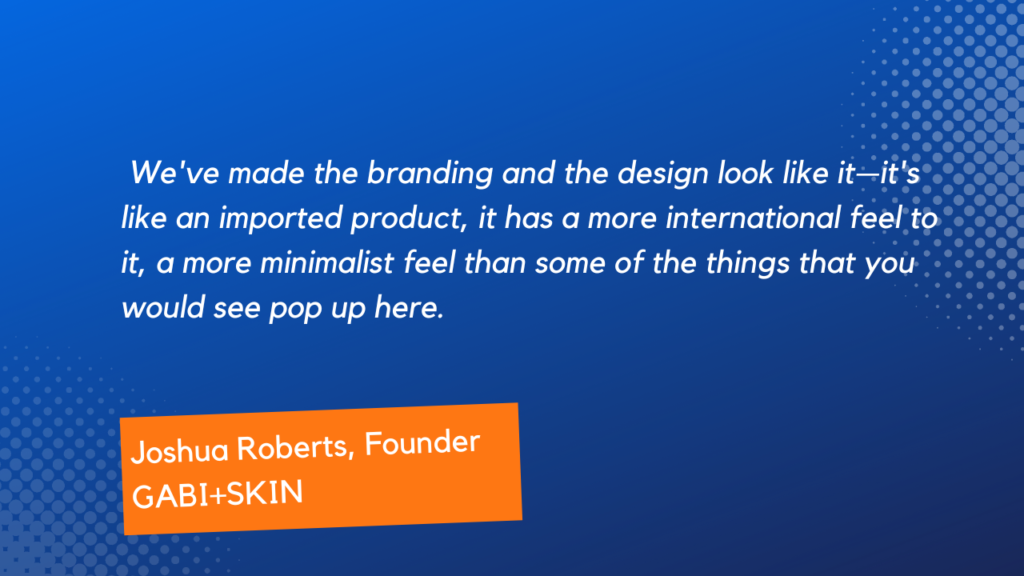
Philosophy and Branding
Because I did come from a corporate background at Acer, I almost ran an internal agency. We had 40 people on my team from many different disciplines, from photography and video to 3D copywriting. We did a lot of the advertising.
We needed to think about really smart ways to produce the amount, the sheer volume of marketing materials that you would need to support more or less a hundred products a year. And that’s a hundred toolkits we need to make for different products, from wearables to projectors, monitors, computers, laptops, etc.
Acer produces a lot of different products. Every product needs a webpage and a set of translations. There’s a lot of stuff to make. How can you build systems and processes to support that amount of marketing assets with a relatively small workforce? 40 people may sound like a lot, but it’s not that many when you consider the amount of things that you need to do.
What we now do for our products with GABI+SKIN, we basically templatize the workflow. We automated a lot of the design materials using database-driven design. I'm all about saving time because we're still a small team. There's only a few people supporting this brand, full-time. I'm not even full-time on it right now, because I still manage Level.
Joshua Roberts Tweet
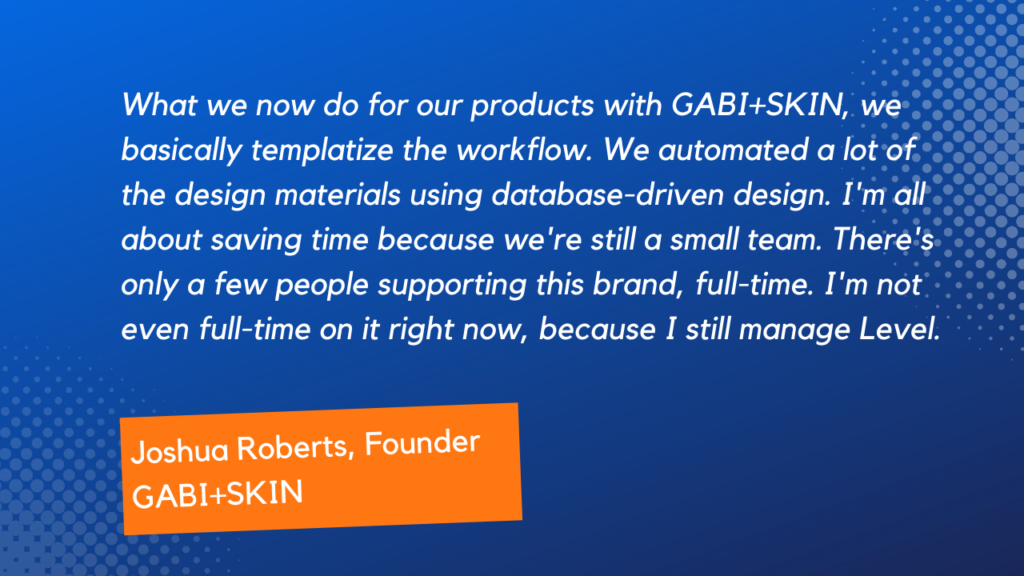
One of the things that we do with GABI+SKIN is, for example, the products are all done in 3D. When we have new products that come, we can simply render new bottles, put new labels on. We can really quickly get new core creative assets up, and we’re ready to go.
We are pretty heavily invested in Notion, which is an all-in-one workspace platform. Probably a lot of people know about it. It’s a really amazing platform. We’ve built a lot of templates that help us run campaigns, whether we’re doing influencer marketing campaigns, or we are doing new product development or doing seasonal campaigns.
Those things are all highly streamlined. We have a one-button click that generates a plan that we fine tune over and over, as we recognize areas that are missing. It really helps us to reduce effort, reduce errors, and stay on track. It helps us to outsource some of the things that we need to do.
All of our primary SEO activities are done through blogging and recycling our blogging content. It’s all pretty much automated through an editorial calendar that automatically notifies the ghostwriters that we have.
Joshua Roberts Tweet
It schedules the translations. A lot of the things are automated. We don’t have it automated by putting it into our backend yet—it’s on my to-do list.
I don’t want people to do repetitive tasks, copying and pasting, emailing etc. I think those things should be as automated as possible, so that we can spend our brain power and our effort doing more strategic thinking, more business development, things that are more difficult to automate.
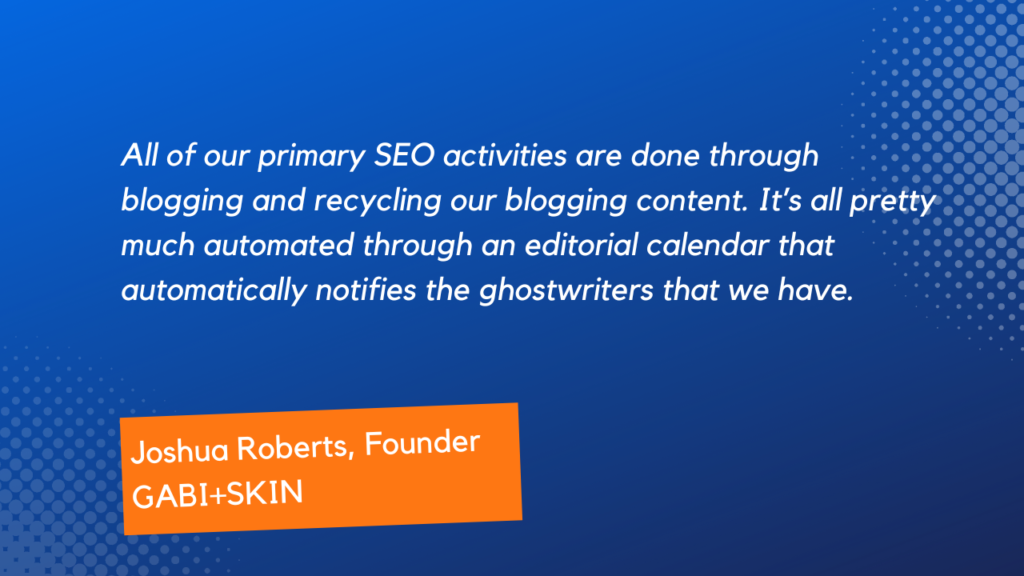
Notion: How GABI+SKIN Utilizes it and Grows
In our global marketing calendar, we would set a period of time, like Mother’s Day promotion. It would generate all of the activities that would need to happen for this campaign. All of the assets that we would need to create, it would automatically paste in any promotional criteria. Our paid media for Google and Facebook would be included in there.
It would basically generate checklists and then, Mandy, my wife, who is basically full-time on GABI+SKIN, would start assigning these tasks to the relevant people within our team and follow-up with everything. We’ve built this over time and we’ve spent a lot of effort in iterating and evolving it so that it becomes more and more streamlined. We add more and more ReadMes and video-help files in there.
We might have 2–5 influencers for this period. They can have access to the page that they need to access; their contracts are in there.
Everything is set, so we don’t need to worry about forgetting things as much, and it just helps keep us on track.
SEO and Paid Advertising: Tactics and Uses
We use a mixture of paid media; organic search through SEO, email marketing, we use Klaviyo—an amazing tool—and influencer marketing. We do have a little bit of additional marketing that comes from other business activities that we’re in. For example, through some channel partners, or through some of the retail ventures that we’ve entered into.
But, basically, it’s SEM, SEO, influencer marketing, and email marketing.
User Experience: How it’s Done
We really wanted to take more of a hand touch approach to everything from the beginning.
Although, we cannot keep up with handwriting cards now, I’m glad we have this problem because it means we’ve grown more. When we first started, my wife was handwriting thank-you notes to every single customer.
Sometimes we would send a quick video to the customers and say, “Hey, Sarah, thanks so much for your order. We want to let you know, we’re dropping this in the mail today. You should receive it by tomorrow or by the latest Friday. If you have any questions, just let us know.” Just short clips that are quite easy to do.
We spent effort to do this, but it made a big difference. When we first started, 10% of the reviews that we got, talked about that handwritten card alone.
People would take photos of it and put it next to the product. We’d always have this feeling of, “Wow, like it makes a difference.” People appreciate that, you know? There are other efforts that we’ve done to make people feel safe in their purchase decision. For example, in Taiwan, we allow customers to come to our website and register for free samples. We send the samples free of charge to their door.
They can use the samples, and then we have a Klaviyo flow that follows-up with this process of series of three emails that say, “Thanks so much for registering. We dropped them in the mail, you should get them by next week.” A week later, “We hope you’ve had a chance to use the products. If you have any questions, please let us know what you think.” And then, finally, we offer them a discount code. Currently, the return on Ad Spend is around three point something.
The form on our website has nearly a 50% registration rate in Klaviyo, for the people who enter this page. Around 50% fill out this form.
Joshua Roberts Tweet
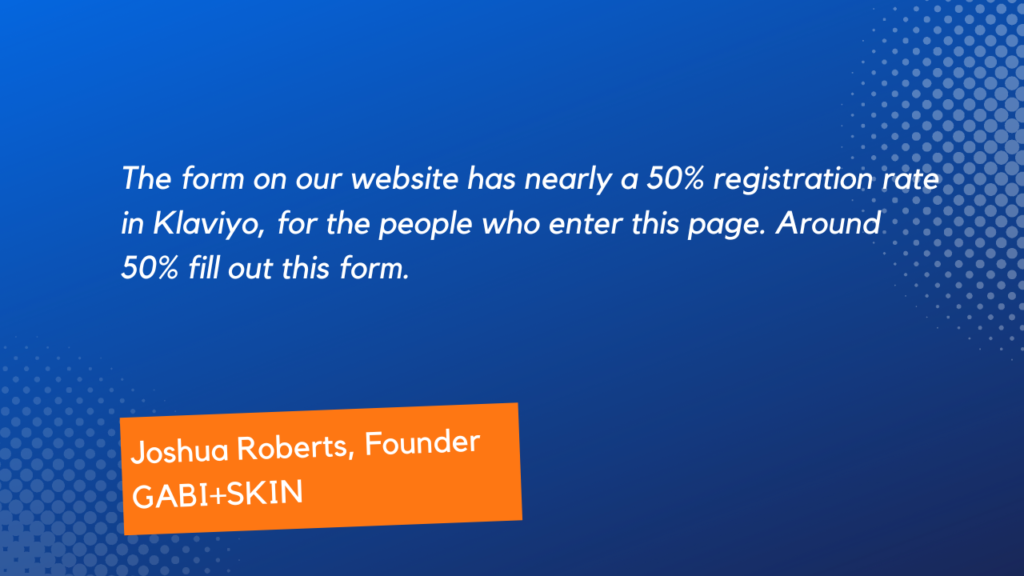
A three X return on Ad Spend—it’s the most successful thing that we have going on so far. We learned the importance of giving away free samples from our retail experience. How that happened was, because of the latest product that we introduced, which was a facial lotion.
It outsold all of the other products, in terms of speed, because that was the only product that had samples. We didn’t have samples for any of the other products. When we were giving away these samples, we realized that people need to try skincare in order to make a decision.
So, if anyone’s running an eCommerce brand that has any sort of sample that can be given away, I think it’s really worth a try to set-up some way to give away free samples.
The other thing that we did is, we put a message on all of our product pages that say, "When you order products from us, we will include the samples. You can try the samples first. If you don't like the product, send it back. Within 30 days, you get your full money back and you've lost nothing. We'll pay for everything." To date, in two years, we have one single return.
Joshua Roberts Tweet
It’s been a really good marketing, engagement tool. It’s something that my wife thought of. And she gets all the credit for this.
It’s worthwhile to test it out because it gets people in, and what you want as a cosmetic brand is to get people and the database, and get them back at one point. If they’re happy with your brand and your products, they will come back, and, ideally, make a break even. But, even if you invest the money upfront, you will get it back down the road. That’s very interesting if you’re thinking long-term.
We’re definitely in it for the lifetime value. Right now, we have around a 30% reorder rate. We’re trying to get that up to 40% by the end of this year. We’re on our way, as we gain more brand awareness and more traction, especially, as we introduce new products.
We’ve recently sent out a big survey to a few thousand customers in our database asking for what they want. We got a lot of really cool feedback, great information and based on that, we’ll introduce new products, new offerings, grow the portfolio, and hopefully, from this point, it can help us grow more.

How to Leverage Strong Customer Relationships for User-generated Content
We get user-generated content through a Shopify App. That’s one way. We use stamped.io.
They have a really great review module. We do get lots of reviews and photos this way. We use Instagram to ask our customers for user-generated content in return for—sometimes, a straight up gift, or sometimes a chance to win a gift.
Those are the primary ways. I would consider influencer marketing as another form of user-generated content. A lot of the people that we work with, they are really great videographers or photographers, and they make great content.
You can see that in the social proof area of our website. It’s not things that we have done ourselves, that all comes from users. Although, influencers are paid, sometimes in exchange for products, sometimes for money. It depends on the sort of size and scale that the influencer has.
How Do You Do Influencer Marketing
We’ve tried a few different ways. There are a few different platforms and databases that we’ve tried. We’ve also tried just manually searching on our own to see what we could discover. We’ve had some of the online and offline retail partners that we’ve worked with have a list of recommended influencers that we could reach out to. We’re pretty picky with who we work with.
We don’t only purely want exposure, we want the right exposure. We want to work with influencers that have a good alignment with our brand. The number of followers is not actually the most important metric to us. It’s actually who the followers are and the amount of engagement that they get, and the sort of brand match.
We want to work with individuals that are more eco-friendly, a bit more thoughtful about how they curate content. If they’re interested in working with us, we add them on Notion and they go through a type of a staging process.
We are looking for more long-term engagements with influencers that have created great content, have helped increase the awareness of our brand and have helped lead to more conversions.
What Are Your Go-to Resources to Upskill
Some friends have helped. You’ve helped. We have a group in our network that has really helped us. Daniel Peleg has helped a lot from the Klaviyo perspective for email marketing. You, from a SEM, PPC perspective. Mark has given us valuable advice on Shopify apps. Branding is something that we always did internally, so I think we had a stronger understanding from this perspective and design, in general.
I do keep up with more creative inspiration through sites like the Hansen Pinterest. I look at lots of like seasonal key visuals and lots of different skincare branding things to see what other people are doing.
I follow Notion a lot. The more I can automate and streamline from this perspective, the better. We really prefer to spend our weekends at the beach and doing things outside, instead of working our entire lives. It’s an important brand for us, but we want to enjoy our lives.
Where Can People Reach You?
You can find me on LinkedIn under Joshua Roberts. The name of our agency is called Level Interactive. It’s thelevel.io.
We do work with startups and established organizations in doing brand identity, system identity design, like corporate information systems, that’s sort of branding. We do web design. We use Shopify exclusively for eCommerce, and we use Webflow, which is a really great no-code platform for pretty much everything else. From simple brochure style websites, catalog websites, branded websites. Those are the main ways.
You can reach me directly at [email protected].

